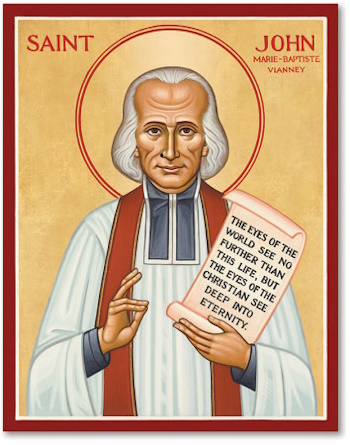
Curé d’Ars, Priest
The French Revolution had a devastating effect on France. Under the ideology of the revolution, religion was attacked and the priesthood forbidden. In the years following, people became pre-occupied with the practical business of re-constructing their lives and found solace in other pursuits. The country was in disarray, Jean-Marie-Baptiste Vianney brought an important, distinctive contribution to the revival of religion.
Born into a peasant family, he had little education and, in the upheavals of the 1790s, worked on his uncle’s farm at Ecully. Church was discouraged but he felt called to the priesthood. His lack of early schooling made study difficult and it was further interupted when he was conscripted into the Napoleonic army. He deserted and only resumed his studies after a general amnesty in 1810. After great struggle he was ordained in 1815. Three years later, at the age of 30, he was appointed as Priest to the remote little village of Ars, north of Lyons.
There had been no real ministry there for years, he had to rebuild the parish. He visited parishioners; re-established education for the children and set up an orphanage for girls; and he set out to redeem his congregation from their sins. He followed a rigid self-discipline, and in his early years at Ars attacked the dancing and drinking of the locals, while placing great stress on the love and mercy of God. In the confessional he read hearts like a book, using confession as a means of correcting people’s habits. He faced some bitter opposition, but shining through his words was a profound love for people. By 1827 the village was transformed.
By then Abbé Vianney was widely regarded as a priest of deep devotion and spiritual skill. People began arriving at Ars from further afield, seeking the counsel of the Curé d’Ars, as he increasingly become known. The pressure, compounded by his own disregard of his health and comfort, made for an enormous spiritual burden. People also came to expect miracles of him, which he attributed to St Philomena.
They had to put on more trains from Lyons to Ars with a separate booking office, in 1853 it was calculated that 20,000 people a year were visiting him. Those who could not visit, wrote to him. While unable to answer all the letters in person, he determined the general scope of the replies. During his later years he spent up to 16 hours a day in the confessional. He desired to leave the parish and devote himself to solitary prayer, but was not given permission by his bishop or the villagers to leave. He died, worn out by his self-denying life-style and devoted ministry to those who came to him. In 1929 he was designated the patron saint of parish priests.
BORN: 1786,
Dardilly (near
Lyons),
France
DIED: 4 August 1859,
Ars (North of
Lyons),
France.
 Welcome
Welcome Calendar
Calendar Today's Word
Today's Word Lauds
Lauds Terce
Terce Sext
Sext None
None Vespers
Vespers Compline
Compline Matins
Matins